Are you looking for an old nickel to add to your collection? If yes, then you should consider getting the 1973 nickel. Join us now as we look at the history, value, and design of the 1973 Jefferson 5-cent coin.
What Is the 1973 Jefferson Nickel Made Of?
The 1973 Jefferson nickel is made of 75% copper and 25% nickel. However, this wasn’t always the composition of the Jefferson nickel. For example, during World War II, the five-cent coin was turned into 56% copper, 35% silver, and 9% manganese because nickel metal was an important raw material on the battlefield.
The specifications of the 1973 Jefferson nickel include the following:
- Value – 5 cents
- Mass – 5 grams
- Diameter – 21.21 millimeter
- Plain edge
The 1973 nickel is part of the Jefferson nickel series, which was started in 1938. It replaced the Indian head nickel.
Felix Schlag designed the Jefferson nickel. His design was used from 1938 to 2004. In 2005, a new design by Joe Fitzgerald was used. Then, the following year, 2006, a new design was made by Jamie Franki.
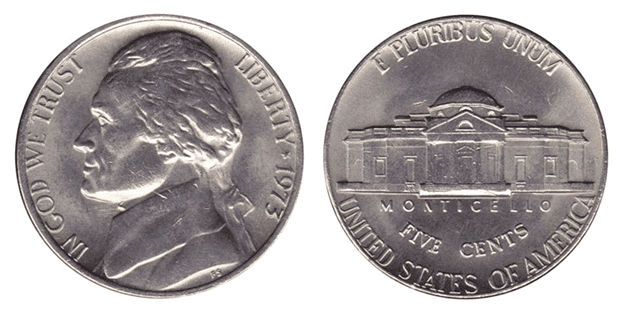
The 1973 nickel features the image of Jefferson on the obverse with inscriptions including IN GOD WE TRUST, LIBERTY, FS, mint mark (if present), and 1973. On the reverse, you’ll find the Monticello Mansion with inscriptions that include E PLURIBUS UNUM, UNITED STATES OF AMERICA, FIVE CENTS, and MONTICELLO.
1973 Jefferson Nickel Varieties
There are three varieties of the 1973 Jefferson nickels. Here’s a comparison table to give you an idea:
| Variety | Mint Location | Mintage |
| 1973 D Jefferson Nickel | Denver | 261,405,000 |
| 1973 P Jefferson Nickel | Philadelphia | 384,396,000 |
| 1973 S Proof Jefferson Nickel | San Francisco | 2,760,339 |
| Total | 648,561,339 |
The mints in Denver, Philadelphia, and San Francisco worked together to meet the demand for the Jefferson nickel in 1973. Together, they produced more than 648 million nickels.
Let’s now have a deeper look at each of the varieties:
1973 D Jefferson Nickel
Edge: Plain
Mint Mark: D
Place of minting: Denver
Year of minting: 1973
Face Value: $0.05 (five cents)
Price: $0.10 to $0.20 (circulated condition)
Quantity produced: 261,405,000
Designer: Felix Schlag
Composition: 75% Copper, 25% Nickel
Mass: 5.00 grams
Diameter: 21.20 mm
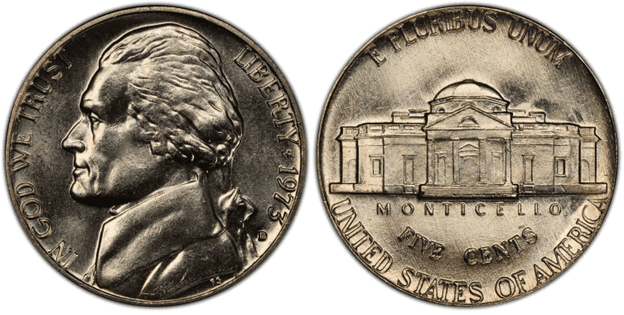
The Denver Mint produced more than 261 million nickels in 1973. You should be able to find a 1973-D Jefferson nickel up to MS65 easily. However, it immediately becomes scarce at MS66. Any grades higher than that are extremely rare, especially the ones with a Full Steps designation.
1973 P Jefferson Nickel
Edge: Plain
Mint Mark: none
Place of minting: Philadelphia
Year of minting: 1973
Face Value: $0.05 (five cents)
Price: $0.10 to $0.20 (circulated condition)
Quantity produced: 384,396,000
Designer: Felix Schlag
Composition: 75% Copper, 25% Nickel
Mass: 5.00 grams
Diameter: 21.20 mm
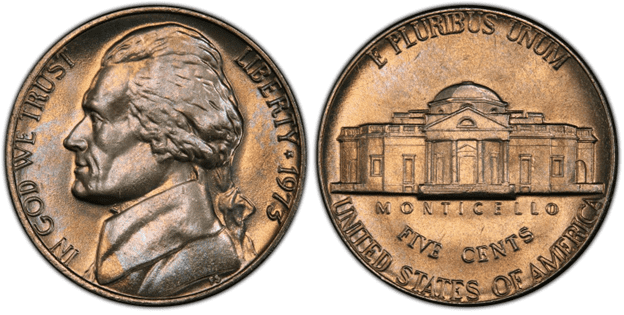
The Philadelphia Mint produced the most number of nickels in 1973, producing more than 384 million pieces. Finding a 1973 P nickel should be easy. They can even be found in circulation. They are common in grades up to MS 65, even in Full Steps. However, nickels in MS 66 condition and higher are difficult to find.
1973 S Proof Jefferson Nickel
Edge: Plain
Mint Mark: S
Place of minting: San Francisco
Year of minting: 1973
Face Value: $0.05 (five cents)
Price: $8 or more (circulated condition)
Quantity produced: 2,760,339
Designer: Felix Schlag
Composition: 75% Copper, 25% Nickel
Mass: 5.00 grams
Diameter: 21.20 mm
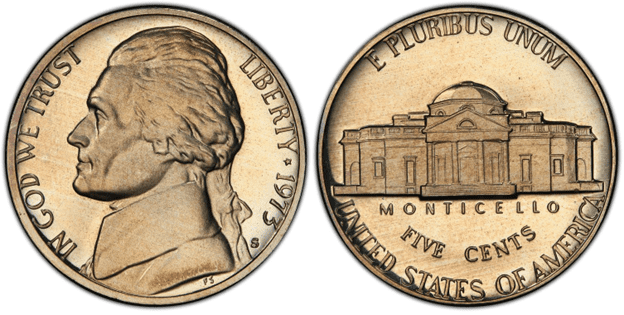
The San Francisco Mint was focused on producing proof nickel coins. The mint issued more than 2.7 million pieces, which is lower than what was produced in the previous year.
What’s great about the 1973-S proof nickels is that they are properly struck. You can find well-defined details on its surface. Thus, you should easily find 1973-S proof coins with grades up to PR69 deep cameo. However, perfect PR70 proof coins are extremely difficult to find.
List Of 1973 Jefferson Nickel Errors
With more than 648 million pieces, there was always the chance that an error coin would appear. That’s why the most interesting part of collecting coins is collecting error coins. They are unique and rare at the same time.
Here are some examples of 1973 Jefferson nickel errors:
Misprint mint error
The Jefferson nickel has the Monticello mansion as its design on the reverse. However, in this error, the Jefferson nickel was accidentally included in the hub during the minting of the Lincoln penny.
As a result, the penny’s reverse die struck the reverse side of the Jefferson nickel. You can visibly see the Lincoln Memorial struck over the Monticello mansion.
Here’s how it looks:
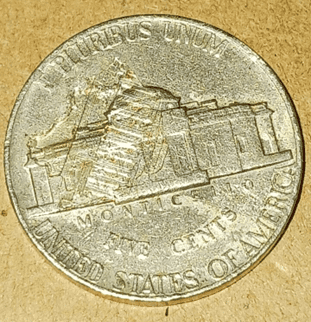
Weak strike
The die should strike the coin with full force to ensure all the elements are engraved on the coin’s surface. However, due to mechanical error, the full strike becomes weak, leaving the coin to have a hazy and blurry look.
Here’s an example:
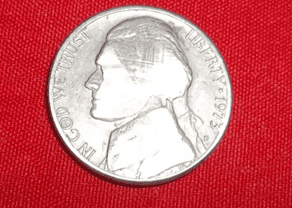
Clipped planchet
During the cutting of the planchet, the machine misfeeds the metal sheet. Thus, a misalignment happens. The imperfect cut leads to a clipped planchet error.
Here’s what a clipped planchet looks like:
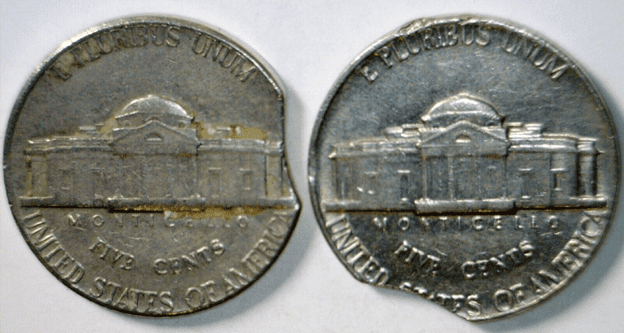
Cud error
The cud error looks like a raised portion or a blob on the coin’s surface. This can happen anymore depending on the damage found on the die. A cud error indicates that the die is severely cracked or broken.
Here’s an example:
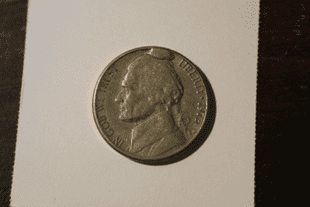
Repunched mintmark
When a mintmark is punched on the planchet twice, it can cause the mintmark to look doubled or thick. Here’s an example:
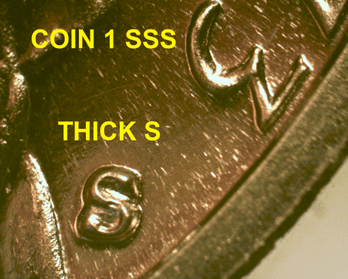
How Much Is 1973 Jefferson Nickel Worth Today?
The biggest question in the minds of collectors when it comes to the 1973 Jefferson nickel is about its value. So, how much is it?
Well, if you look at the face value and melt value, the 1973 Jefferson nickel isn’t much. You only get 5 cents for its face value and $0.0650 for its melt value. The price of a circulated 1973 nickel may be less than 30 cents.
However, you should realize that 1973 Jefferson nickels were sold for hundreds and even thousands of dollars. These nickels usually are the ones with rare and beautiful conditions.
To help you appreciate the value of the 1973 5-cent coin, here’s a table of auction records for each variety:
| Coin | Condition | Grade | Sold date | Sold by | Value |
| 1973 S Proof Jefferson Nickel | Perfect Uncirculated | PR – Full Steps | June 13, 2018 | eBay | $5,550 |
| 1973 P Jefferson Nickel | Gem Uncirculated | MS 66 | September 22, 2010 | Heritage Auctions | $2,300 |
| 1973 D Jefferson Nickel | Superb Gem Uncirculated | MS 67 (Full Steps) | April 7, 2021 | Heritage Auctions | $552 |
How Does The Grading System Work?
Coin grading service providers would examine a 1973 Jefferson nickel and look into its strike, preservation, attractiveness, luster, and color. Based on their findings, they will give a grade between 1 to 70 by using the Sheldon Scale. Aside from that, they would use adjectives such as Good, Fine, and Uncirculated to describe the 1973 nickel quickly.
Professional numismatists joined in the 1970s and established CoinGrading standards, known as the Sheldon Scale. These numismatists now assign grades at key places on the seventy-point scale, using the most regularly utilized numeric points in conjunction with the original adjective grade. The following are the most common coin grades:
- (P-1) Poor – Indistinguishable and probably damaged; if used, must have a date and mintmark; otherwise, rather battered.
- (FR-2) Fair – Nearly smooth, but without the damage that a coin graded Poor often possesses. The coin must have enough detail to be identified.
- (G-4) Fair – Inscriptions have merged into the rims in some areas, and important elements have been mostly erased.
- (VG-8) Very Good- A little weathered, but all primary design elements are visible, albeit faintly. There is little, if any, central detail left.
- (F-12) Good – The item is very worn, yet the wear is even, and the overall design details stand out clearly. Rims are almost completely isolated from the field.
- (VF-20) Very Fine – Moderately weathered, with some finer features still visible. The motto or all letters of LIBERTY are readable. Both sides of the coin have entire rims separated from the field.
- (EF-40) Extremely Fine – Gently used; all gadgets are visible, and the most important ones are bold. The finer details are bold and clear; however, light wear may be seen.
- (AU-50) Uncirculated – Slight evidence of wear on the coin’s design’s high points; it may have contact marks; eye appeal should be adequate.
- (AU-58) Uncirculated Choice – Slight traces of wear, no severe contact marks, almost full mint shine, and great eye appeal.
- (MS-60) Mint State Basal – Strictly uncirculated; no indication of wear on the coin’s highest points, but an unsightly coin with reduced luster, visible contact marks, hairlines, and other flaws.
- (MS-63) Mint State Acceptable – Uncirculated, but with contact scratches and nicks, little reduced shine, but otherwise appealing appearance. The strike is weak to average.
- (MS-65) Mint State Choice – Uncirculated with great mint shine, little contact blemishes, and exceptional eye appeal. The strike is unusually severe.
- (MS-68) Mint State Premium Quality – Uncirculated with superb luster, no obvious contact marks to the naked eye, and exceptional eye appeal. The strike is quick and appealing.
- (MS-69) Almost Perfect Mint State – Uncirculated with perfect brilliance, a sharp and appealing strike, and extremely good eye appeal. A near-perfect coin with minor imperfections in the planchet, strike, and contact markings (seen only under 8x magnification).
- (MS-70) Mint State Perfect – Under 8x magnification, no tiny imperfections are discernible; the strike is crisp, and the coin is perfectly centered on a beautiful planchet. Rarely seen on a coin, this coin is bright and whole, with original luster and exceptional eye appeal.
Moreover, a circulated 1973 Jefferson nickel would be graded specifically based on the number of steps on the Monticello mansion. If the stairs have at least five clear and visible steps, then the coin is categorized as “Full Steps.”
Where To Buy Or Sell 1973 Jefferson Nickel?
The 1973 Jefferson nickel is available online. The websites you can go to include eBay, Coin Appraiser, Amazon, USA Coin Book, and Etsy, to name a few. The best thing about buying online is that they are convenient, easy, and quick. Of course, be sure to buy from trusted and reputable vendors. There are a lot of scammers out there who might try to deceive you.
Aside from the Internet, you can visit coin shops and auction houses. You can also join clubs or groups of coin collectors. Having a lot of contacts would help you find more places to buy and sell 1973 Jefferson nickels.
FAQs
Where is the mint mark on a 1973 nickel?
The mint mark on a 1973 nickel is found on the obverse side of the coin. Look for it near the tip of the pigtail of Jefferson, just below the year, “1973.” The mint mark you’ll see should either be “D” or “S.”
Is a 1973 nickel worth anything?
Yes, a 1973 nickel can be worth a lot of money if it is rare, still in good condition, and has received a high grade. Just to give you an idea, a 1973 S-proof nickel with a grade of PR70 was sold for $5,550 in June 2018.
Is a 1973 no mint mark nickel rare?
No, the 1973 no-mint mark nickel is not rare. There were more than 384 million of them in 1973. However, 1973 no mint mark nickels can be rare if they have unique attributes such as being in good condition or having production errors.
1972 Nickel Value Guide
1972 Half Dollar Value Guide
1972 Dime Value Guide
1973 Lincoln Penny Value Guide (Incld. Rare Varieties)
1974 Lincoln Penny Value Guide (Incld. Rare Varieties)
1974 Kennedy Half Dollar Value Guide (Incld. Rare Varieties)
